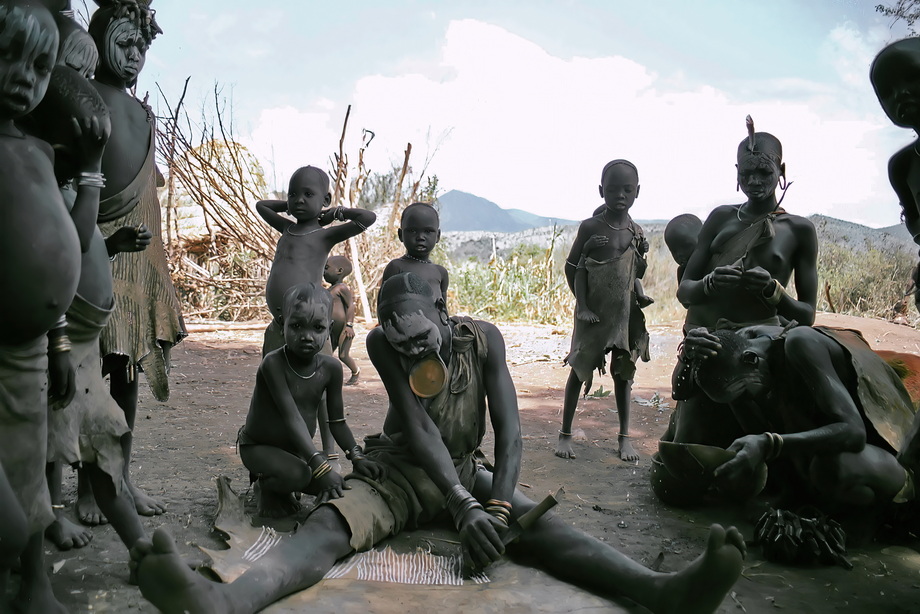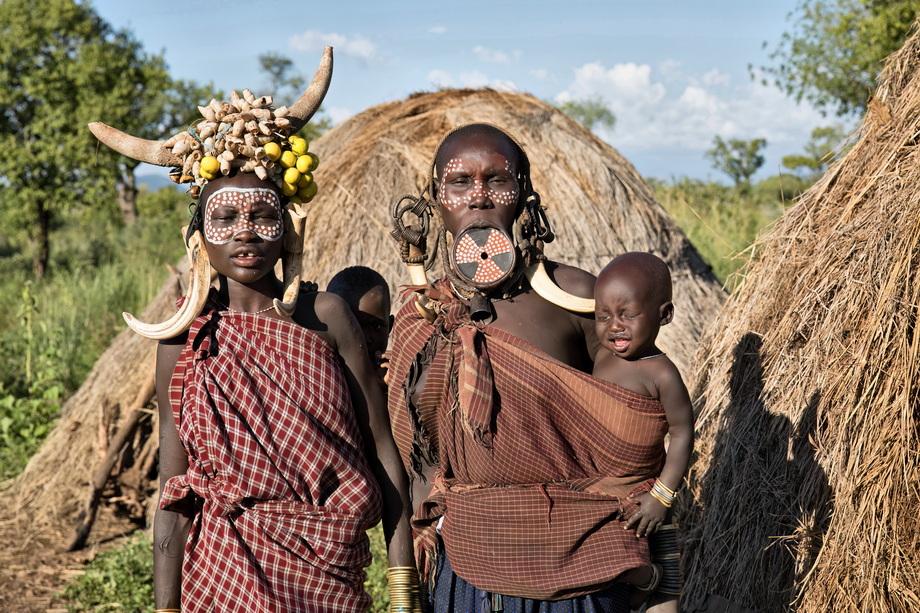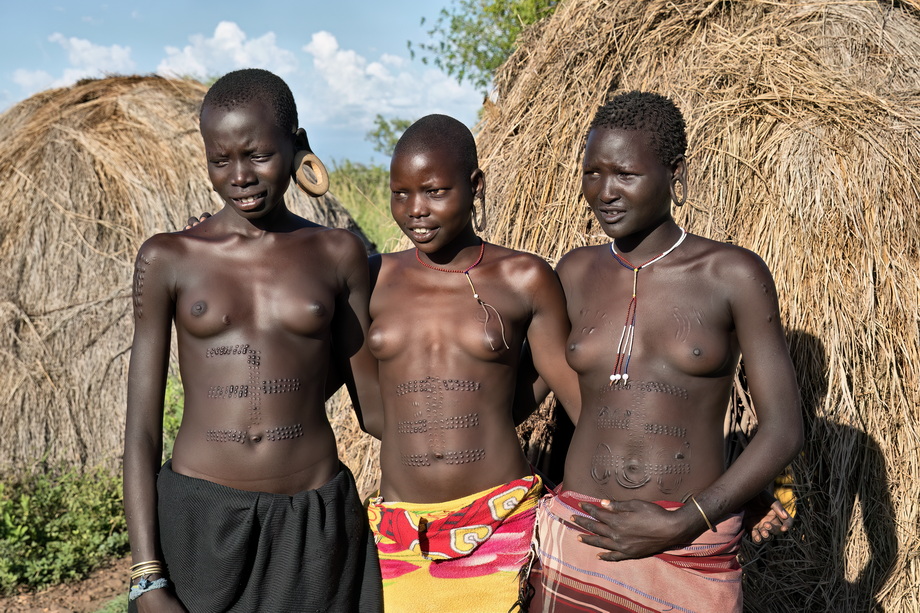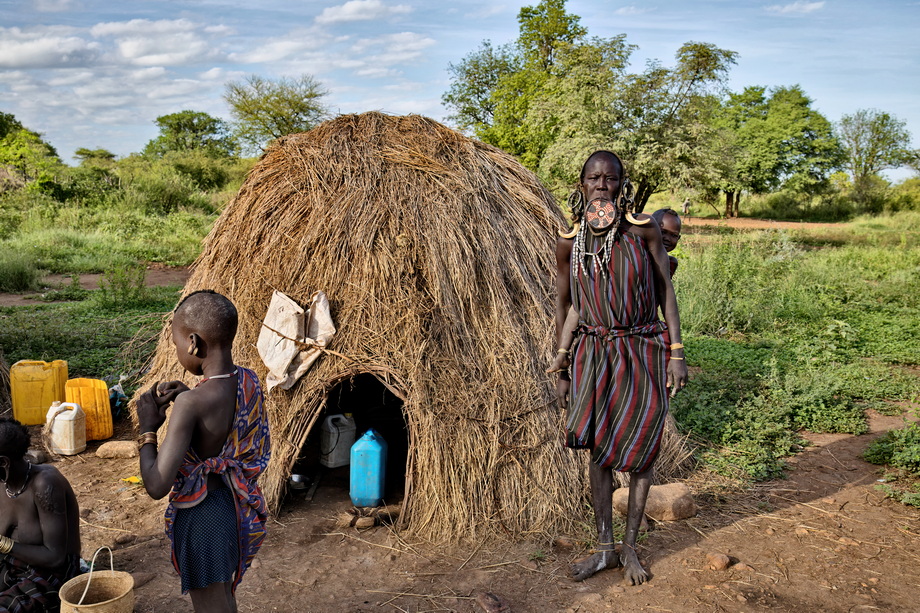

The Mursi (or Mun as they refer to themselves) are a Nilotic pastoralist ethnic group in Ethiopia.
They principally reside in the Debub Omo Zone of the Southern Nations, Nationalities, and People's Region, close to the border with South Sudan.
According to the 2007 national census, there are 7,500 Mursi, 448 of whom live in urban areas; of the total number, 92.25% live in the Southern Nations, Nationalities, and People's Region (SNNPR).
Surrounded by mountains between the Omo River and its tributary the Mago, the home of the Mursi is one of the most isolated regions of the country. Their neighbors include the Aari, the Banna, the Bodi, the Karo, the Kwegu, the Nyangatom and the Suri.
They are grouped together with the Me'en and Suri by the Ethiopian government under the name Surma.

The Mursi speak the Mursi language as a mother tongue. It is classified as Surmic, which is a branch of the Nilo-Saharan language family. Mursi is closely related (over 80% cognate) to Me'en and Suri, as well as Kwegu. According to the 1994 national census, there were 3,163 people who were identified as Mursi in the SNNPR; 3,158 spoke Mursi as their first language, while 31 spoke it as their second language. According to the analytical volume of the 1994 national census, where Mursi was grouped under Me'en, 89.7% were monolingual, and the second languages spoken were Bench (4.2%), Amharic, the official language of Ethiopia (3.5%), and Kafa (1.1%).
Two orthographies for the Mursi language exist. One is the Amharic-based, although the Mursi language is one the Surmic languages with incompatible vowel structures and stressed and unstressed consonants compared to Amharic. The second is the more suitable Latin-based alphabet. The Latin-based orthography was developed by David Turton and Moges Yigezu of Addis Ababa University.

In the Lower Omo Valley there is a confluence of two out of the four African language families—Afro-Asiatic and Nilo-Saharan. Within the Nilo-Saharan language group, there is Surmic (the agro-pastoralists—the Chai, Tirma and Balé (collectively known as Suri), Mursi (Mun), Bodi-Me’en; the agriculturalists—Tishana-Me’en and Majang; the agro-hunter-gathers— Kwegu/Koegu) and Eastern Sudanic/Karimojong (the agro-pastoralists— Nyangatom and Turkana).
Within the Afro-Asiatic language family there is Omotic (the agro-pastoralists—Hamar, Banna, Bashada and Kara; the agriculturalists– Dizi, Dime, Maale, Basketto, Aari) and Cushitic (the agro-pastoralists— Dassanech and Borana; the agriculturalists— Tsamaï, Arbore and Konso).
The Mursi as we know them today are the product of a large scale migratory movement of cattle herding peoples in the general direction of the Ethiopian highlands. Three separate movements may be distinguished in the recent history of the Mursi, each the result of growing environmental pressure associated with the drying out of the Omo basin over the last 150-200 years. For example, there are oral histories that recount the crossing from the west to the east bank of the Omo River.

The Mursi way of life revolves around seasonal patterns and environmental niches. In this lowland area rainfall is unpredictable, so the Omo River is a life-line for them and for their neighbours. Its annual floods provide the only predictable source of moisture for cultivation.
This is an immensely bio-diverse area where hippos wallow, birds feed, crocodiles hunt, and where elephants, buffalo, leopards and lions roam. This area is also a designated UNESCO World Heritage Site because it is rich in human fossil remains of fundamental importance in the study of human evolution.
The population is divided into five main local groups, or bhuranyoga (sing. bhuran), which are named, from north to south, Baruba, Mugjo, Biogolokare, Ariholi and Gongulobibi. These groups are not clearly bounded, geographically, but they give society its structure. Members of the same bhuran cooperate on a daily basis, in both subsistence and politico-ritual activities.

Like many agro-pastoralists in East Africa, the Mursi experience a force greater than themselves, which they call Tumwi. This is usually located in the Sky, although sometimes Tumwi manifests itself as a thing of the sky (ahi a tumwin), such as a rainbow or a bird. The principal religious and ritual office in the society is that of the Kômoru, the Priest or Shaman. This is an inherited office, unlike the more informal political role of the Jalaba. The Kômoru embodies in his person the well-being of the group as a whole and acts as a means of communication between the community and the god (Tumwi), especially when it is threatened by such events as drought, crop pests and disease. His role is characterized by the performance of public rituals to bring rain, to protect men, cattle and crops from disease, and to ward off threatened attacks from other tribes. Ideally, in order to preserve this link between the people and the Tumwi, the Kômoru should not leave Mursiland or even his local group (bhuran). One clan in particular, Komortê, is considered to be, par excellence, the priestly clan, but there are priestly families in two other clans, namely Garikuli and Bumai.
The religion of the Mursi people is classified as Animism, although there is a Serving in Mission Station in the northeastern corner of Mursiland, which provides education, basic medical care and instruction in Christianity.
The Mursi economy is based upon the integration of three main subsistence activities, rain-fed cultivation, flood-retreat cultivation and cattle herding. none of these is sufficient in itself, nor even in combination with one of the other two, to provide a regular and reliable subsistence, but each make a vital to the overall viability of the economy.
They cultivate at the Omo from September to February each year and then they return to the inland grassy plans to cultivate during the rainy season from March and August. People cultivate sorghum and corn, and sometimes they grow beans and pumpkins. Cattle provide milk which is often eaten with porridge. Cattle are vital in times of drought, since they can be exchanged in local towns in exchange for money to buy grain.

There are various rites of passage, educational or disciplinary processes that people undergo. Lip-plates are a well known aspect of the Mursi and Surma, who are probably the last groups in Africa amongst whom it is still the norm for women to wear large pottery or wooden discs or ‘plates’ in their lower lips.
Women of the Mursi tribe may have their lips cut at the age of 15 or 16. A small clay plate is then inserted into the lip. Through the years, larger plates are inserted into the lip causing it to stretch. The larger the clay plate, the more the woman is worth before she gets married. It is said that the clay plates were originally used to prevent capture by slave traders. Although very unique and part of their tradition, the Mursi women only wear the plates for a short time because they are so heavy and uncomfortable.
It was said that this practice was first carried out to make them look ugly when Arab merchants continually raided their villages in search of slaves. That explanation has been rejected as studies reveal that the plates are a symbol or expression of social status.
The supposed historical link between lip-plates and the activities of slave traders is an idea that goes back to colonial times. In an article in the September 1938 issue of National Geographic Magazine, C. and M. Thaw report meeting women with large plates in both their upper and lower lips near Fort Archambault, on the River Chari, about 400 miles southeast of Lake Chad, in what was then French Equatorial Africa:
"Here both the upper and lower lips of girl babies are pierced and small wooden plugs inserted into the holes. As they grow up, these holes are gradually increased in size until they reach the dimensions of large soup plates… This form of disfigurement was begun centuries ago to discourage slave raiders, the French Administrator told us. Why it didn’t discourage the young men of the tribe, as well, we will never know. (Thaw & Thaw 1938: 357)"
This ‘explanation’ of the lip-plate, as a ‘form of disfigurement’, tells us more about the assumptions and values of those who find it persuasive than it does about the practice which it is supposed to explain. One obvious problem with it is that lip-plates are unique neither to Africa, nor to women. Amongst the Kayapo of Brazil, for example, senior men wear ‘a saucer-like disc some six centimetres across’ (Turner, 1980: 115) in the lower lip.
"The lip-plug, which reaches such a large size among older men, is incontestably the most striking piece of Kayapo finery. Only
males have their lips pierced. This happens soon after birth, but
at first only a string of beads with a bit of shell is placed in the
their backwardness by outsiders and that it will help to prolong
their exclusion from the economic and social benefits
of incorporation into the Ethiopian state. In particular, it
will be an obstacle to the education of girls. Here I should mention the recent activities of Protestant missionaries
who, since 1989, have established themselves in the Mago Valley, where a group of Mursi had migrated a few years
earlier because of drought. The missionaries have not, as
far as I know, spoken out specifically against the lip-plate.
But their converts, who are at present concentrated around the mission station and may number in the region of 50
individuals, are likely to be at the forefront of efforts,
coming from within the community itself, to abandon such ‘traditional’ practices and customs."
However,the real truth is that the boundary of the body, the skin, is everywhere treated as the boundary of the biological individual and as ‘the frontier of the social self. When seen in this light, the lip-plate worn by Mursi women is an expression of female social adulthood,beauty and reproductive potential.
The Mursi women also paint their bodies and face in white.

Scarring or tribal beatification marks can be used to accentuate the shape of the female body. Mursi (or Murzi) women of Ethiopia have elaborate symmetrical scarring patterns made on their bodies. They focus on the stomach but also curve around the breasts. The flat skin of the stomach is raised with sharp thorns and then cut.
Mursi society has a high level of infant mortality and raising children is greatly valued. Scarring around the hips, on the stomach and breasts can highlight areas associated with fertility. The scars themselves can also remain sensitive for years following their creation and be a source of heightened sensation for those with scars and anyone who touches them.
Ceremonial duelling (thagine) is a highly valued and popular activity of Mursi men, especially unmarried men, and a key marker of Mursi identity, and is a form of ritualised male violence. Men of the Mursi also use white paint for their bodies and faces.
Just like any other ethnic tribe in the lower valley, the men must pass a test before they can get married. A Mursi man is given a stick called a Donga and must face one opponent. The men then battle it out, beating each other with the sticks.
During the fight they protect their most vulnerable parts with coarse cotton cloths. The ceremony takes place every year after the harvests (November- January). All the Surmic groups participate in this ritual as another step up the social ladder for their young men. The fight is symbolic; the adversary has to be defeated without being killed. The victorious young man wins special prestige and, above all, attention from the young, single women. If an adversary is killed, there are serious reprisals for the young man and his family.
The first fighter to submit loses and the winner is taken by a group of women to determine who he will marry. Men of the tribe also practice scarification. Like other tribes, this is the marking of an enemy killed by him.
Although they are known to be aggressive and combative, the Mursi are more then happy to allow you to take pictures of them. However, they keep count of every picture taken and will charge you for each one.
Age-Sets are an important political feature, where men are formed into named ‘age sets’, and pass through a number of ‘age grades’ during the course of their lives; married women have the same age grade status as their husbands.
Leadership: There are two types of leaders, priests (Kômorenna) and orators (Jalaba). Priests occupy the only formally defined leadership role in the society. This is an inherited office which has both political and ritual significance.
Jalaba are men who have achieved a position of influence in the local community, not because they occupy a formal office, whether by inheritance, appointment or election, but because of their personal qualities and oratorical skills.







Sources: